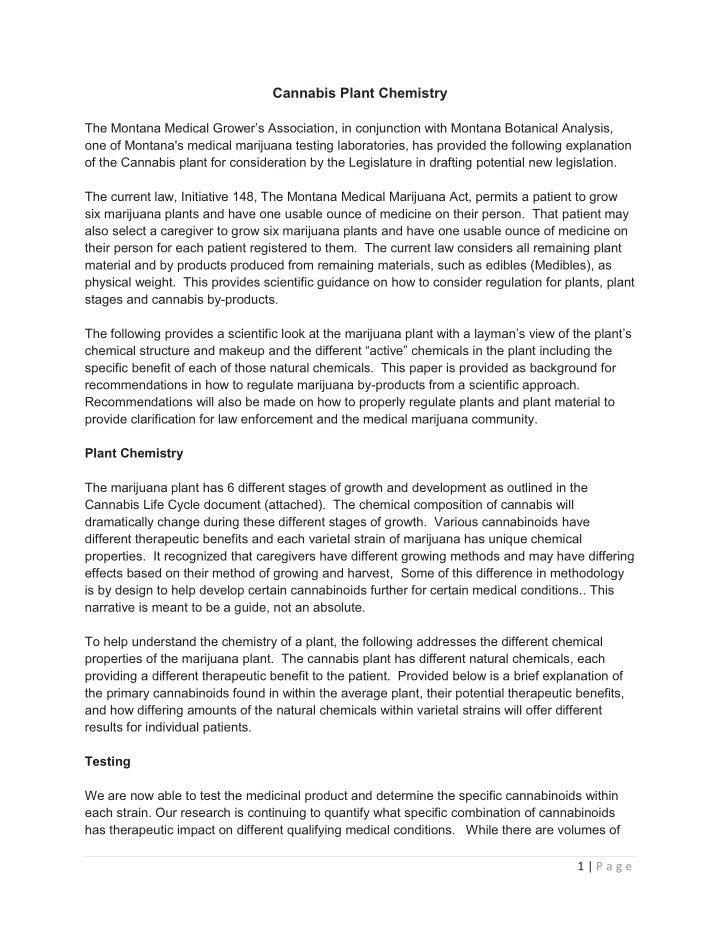



Cannabis Plant Chemistry The Montana Medical Grower’s Association, in conjunction with Montana Botanical Analysis, one of Montana's medical marijuana testing laboratories, has provided the following explanation of the Cannabis plant for consideration by the Legislature in drafting potential new legislation. The current law, Initiative 148, The Montana Medical Marijuana Act, permits a patient to grow six marijuana plants and have one usable ounce of medicine on their person. That patient may also select a caregiver to grow six marijuana plants and have one usable ounce of medicine on their person for each patient registered to them. The current law considers all remaining plant material and by products produced from remaining materials, such as edibles (Medibles), as physical weight. This provides scientific guidance on how to consider regulation for plants, plant stages and cannabis by-products. The following provides a scientific look at the marijuana plant with a layman’s view of the plant’ s chemical structure and makeup and the different “active” chemicals in the plant including the specific benefit of each of those natural chemicals. This paper is provided as background for recommendations in how to regulate marijuana by-products from a scientific approach. Recommendations will also be made on how to properly regulate plants and plant material to provide clarification for law enforcement and the medical marijuana community. Plant Chemistry The marijuana plant has 6 different stages of growth and development as outlined in the Cannabis Life Cycle document (attached). The chemical composition of cannabis will dramatically change during these different stages of growth. Various cannabinoids have different therapeutic benefits and each varietal strain of marijuana has unique chemical properties. It recognized that caregivers have different growing methods and may have differing effects based on their method of growing and harvest, Some of this difference in methodology is by design to help develop certain cannabinoids further for certain medical conditions.. This narrative is meant to be a guide, not an absolute. To help understand the chemistry of a plant, the following addresses the different chemical properties of the marijuana plant. The cannabis plant has different natural chemicals, each providing a different therapeutic benefit to the patient. Provided below is a brief explanation of the primary cannabinoids found in within the average plant, their potential therapeutic benefits, and how differing amounts of the natural chemicals within varietal strains will offer different results for individual patients. Testing We are now able to test the medicinal product and determine the specific cannabinoids within each strain. Our research is continuing to quantify what specific combination of cannabinoids has therapeutic impact on different qualifying medical conditions. While there are volumes of 1 | P a g e
research on different cannabinoids, there are a number of groups in Montana focusing on further development. There are currently two commercial testing laboratories in Montana and it is anticipated later this year, testing locations will become more available and affordable. Eventually, it is anticipated that all medical marijuana in Montana will be tested, possibly within 24 months in Montana. Cannabinoids There are at least 66 different cannabinoids found in a cannabis plant, as well as various terpenes, flavinoids, and other hydrocarbons. The majority of scientific research presently available has focused on Tetrahydrocannabinol (THC) and Cannabidiol (CBD). It should be emphasized that THC and CBD are not the only medicinally active compounds found in cannabis. To fully understand this plant as a medicinal product, a more detailed discussion of the complex chemistry observed in cannabis plants must be addressed. Tetrahydrocannabinol (THC) THC is the only natural chemical in cannabis plants that provides significant psychotropic responses. In the 1960’s the intent by illegal growers was to increase the percentage of THC thus reducing the potency of the other medically beneficial cannaboids. Cannabis strains currently found in Montana will include a wide variety of plant names and natural chemical makeup with each strain being different. Testing of cannabis in Montana has shown THC levels from 2% to 21% with an average of 13.5%. Medicinally, cannabis with these levels appears to ease moderate pain and to be neuroprotective. It should be emphasized that patients in Montana, in general, often seek cannabis strains with lower THC concentrations. The primary constituent of cannabis, THC, is approved by the Food and Drug Administration (FDA) for oral administration as appetite stimulant in the case of anorexia associated with weight loss in patients with HIV/AIDS. Cannabidiol (CBD) CBD is the non-psychoactive compound found in cannabis that has a variety of medicinal applications. CBD is thought to have anti-psychotic effects, dampening the anxiety and panic reactions to THC. It is also thought to improve wakefulness and to enhance THC’s activity against pain. Taken by itself, CBD has anti-inflammatory, anti-anxiety, anti-epileptic, sedative and neuroprotective actions. It is also a potent anti-oxidant, protecting against chemical damage due to oxidation. Studies have suggested that CBD may also protect against the development of diabetes, certain kinds of cancer, rheumatoid arthritis, brain and nerve damage due to stroke, alcoholism, nausea, inflammatory bowel disease and Huntington’s disease. Cannabinol (CBN) CBN is a degradation product of THC and can be used to provide information about the age, treatment, and quality of a cannabis plant. Excessive CBN concentrations are generally not desirable for medical patients. 2 | P a g e
The following provides an example of how different strains may impact different medical conditions. As research continues with new testing procedures and facilities available statewide, within 2 years, Montana will again lead the country in research. 3 | P a g e
Recommend
More recommend